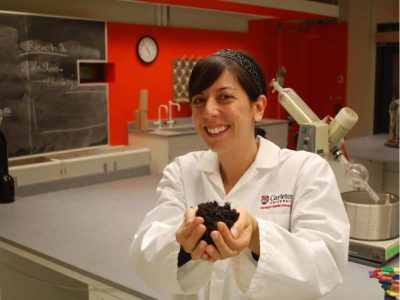 Maria DeRosa, Department of Chemistry
Maria DeRosa, Department of Chemistry
By Ariel Root
“Something that’s important to note about nanoparticles, is that it’s more than just their size; they’re also special. There’s something special about them: they have greater surface area; they have interesting electronics; they glow. There’s always something different about a nano-material that makes it separate from just a small amount of the bulk.” Maria DeRosa, TEDxCarleton U, 2010.
From her graduate school days, Maria DeRosa has been interested in developing novel bionanotechnology, called aptamers, for detecting molecular targets of relevance to health. “Nano science and nano tech are looking at ways to apply these technologies to important problems. So…how can nanotechnology help?”
DeRosa is an Associate Professor in the Department of Chemistry and Institute of Biochemistry, and also works in collaboration with government researchers from Agriculture and Agrifood Canada, Health Canada and Environment Canada, as well as industrial partner and farmer groups. Her educational training as a material scientists during her doctoral years at Carleton, combined with her post-doctoral work determining how DNA works in the body, as well as an external sensor, prepared DeRosa with the necessary skills to work with aptamers.
An aptamer is a small single-strand of DNA or RNA sequences that bind specifically to a variety of target molecules, and therefore have many environmental, agricultural, and health applications. Specifically, aptamers can be bound to neurotransmitters, allowing inflow of dopamine into the brain, but can also increase delivery efficiency of fertilizers into plants. DeRosa is interested in the use of aptamers for the design of novel bionanotechnology related to biosensing and catalysis.
 DeRosa has long had an interest in research that provides understanding of bionanotechnology at the molecular level, but at the same time has tangible benefits beyond expanding knowledge, and the scientific community. When DeRosa started her faculty position at Carleton, she was introduced to the health impacts of mycotoxins.“These secondary metabolites that are produced by fungi can be widespread on crops and food commodities. I realized that developing low cost, easy-to-use technology that detects these contaminants in food would be a worthy pursuit and could have a global impact on health,” resulting in her pursuit of developing aptamers for mycotoxins in food.
DeRosa has long had an interest in research that provides understanding of bionanotechnology at the molecular level, but at the same time has tangible benefits beyond expanding knowledge, and the scientific community. When DeRosa started her faculty position at Carleton, she was introduced to the health impacts of mycotoxins.“These secondary metabolites that are produced by fungi can be widespread on crops and food commodities. I realized that developing low cost, easy-to-use technology that detects these contaminants in food would be a worthy pursuit and could have a global impact on health,” resulting in her pursuit of developing aptamers for mycotoxins in food.
“We need food because food gives us the energy, and it gives us the nutrients and building blocks that we need in order for our cells, our proteins, and our tissues, to function…it’s central to us, and to our health.” Ingestion of mycotoxins from foods can cause cancer or stunting, and can affect both humans and animals. In the Canadian context, detection of these toxins is performed in a laboratory setting, though aptamers could enable farmers to test on site; a helpful and economical tool. In the developing world however, mycotoxins are a health crisis, and the ability to accurately detect mycotoxins is not always available in any sort. “We need to be able to detect these toxins in cheapest, and most practical, way,” which means farmers need to be able to perform these tests on site, and in the field. For instance, DeRosa shows a USB flash-drive sized stick, and explains that the farmer would grind up some grain, mix with a bit of water, and place a droplet onto the sensor. If mycotoxins were present, a small plus sign would appear—similar to a pregnancy test.
 DeRosa explains that the key is to make the aptamers cost-efficient while maintaining accuracy. “Aptamers have to be specific, and we can’t have false negative, or false positives. They have to maintain accuracy at low levels.” However, many hurdles persist regarding aptamer design and the complexities of food matrices. “In pure water, even low-end versions can find a toxin. But in food, there are proteins, and bacteria… the tough part is the intricate mix [within a food].” DeRosa has successfully created an aptamer that will bind to norovirus in meat sources, but she indicates that each food has a unique matrix of components, and therefore aptamer design has to be reinvented and redefined for each toxin and food source. In a lab, tests can clean, separate, or count components of the food, “but at the farm or grain elevator, or in a developing country… that’s the challenge.”
DeRosa explains that the key is to make the aptamers cost-efficient while maintaining accuracy. “Aptamers have to be specific, and we can’t have false negative, or false positives. They have to maintain accuracy at low levels.” However, many hurdles persist regarding aptamer design and the complexities of food matrices. “In pure water, even low-end versions can find a toxin. But in food, there are proteins, and bacteria… the tough part is the intricate mix [within a food].” DeRosa has successfully created an aptamer that will bind to norovirus in meat sources, but she indicates that each food has a unique matrix of components, and therefore aptamer design has to be reinvented and redefined for each toxin and food source. In a lab, tests can clean, separate, or count components of the food, “but at the farm or grain elevator, or in a developing country… that’s the challenge.”
DeRosa indicates that she has “wonderful students and colleagues who keep [her] inspired and driven.” She is particularly interested in developing ideas in collaboration with her students and colleagues, who have all helped to define specific problems, or specific foods, as related to aptamers. Together, she enjoys developing a solution. “I don’t know if I’ve had an impact outside of the scientific community yet, but I’m hopeful that one is coming.” DeRosa recalls that her research group was one of the first to apply aptamers to food and agricultural problems, “… and now I see that many other research groups are also working in this area. I hope that soon all these efforts (in our group and others) will pay off in the form of technology that can be applied outside of the lab and in the real world.”
For Dr. DeRosa’s contact information, go here.